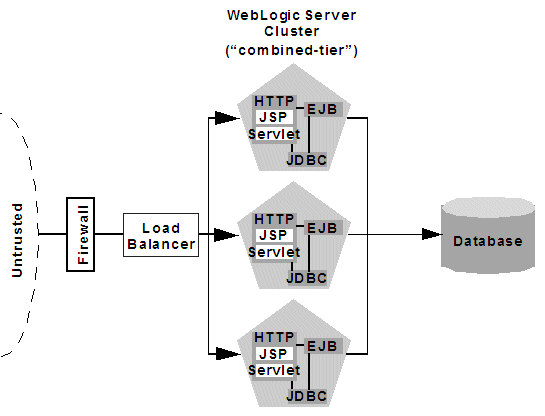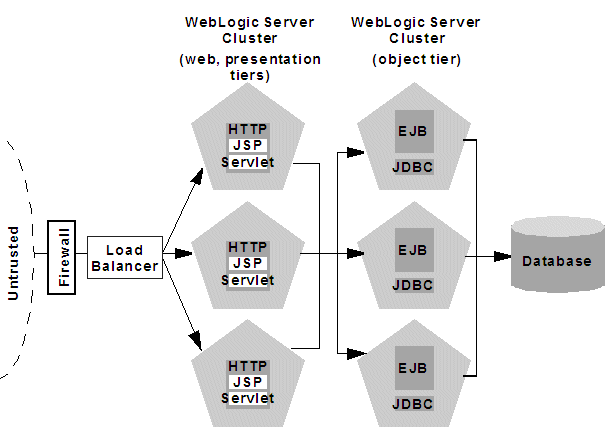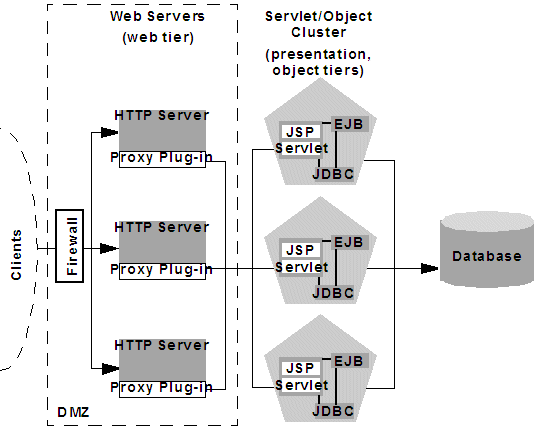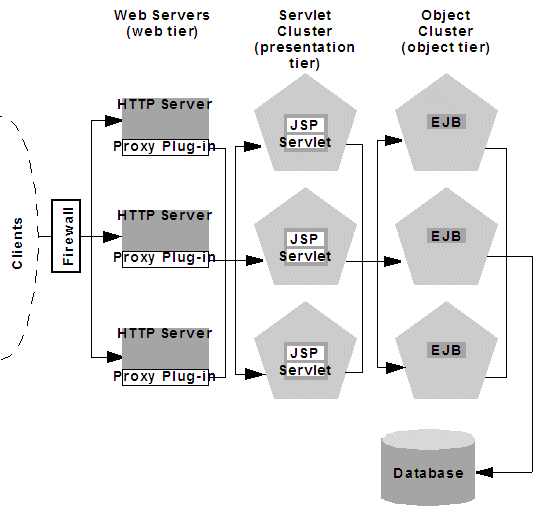Contents
Web Application Tiers
* Web tier: provides static web content, e.g. HTML pages.
* Presentation tier: provides dynamic web content, e.g. Servlets and JSPs.
* Object tier: provides Java objects, e.g. EJBs and RMI classes, and their associated business logic.
Recommended Basic Architecture
* Combined tier architecture: all tiers of web application are deployed to the same WebLogic Server cluster.
* Pros:
– Easy administration with a single cluster.
– Flexible load balancing with load balancer in front of WebLogic server cluster.
– Robust security with firewall in front of load balancer.
– Optimal performance for applications where most presentation tier access object tier.
* Cons:
– Single point load balancing at web tier.
Recommended Multi-Tier Architecture
* Uses two separate clusters:
– One for static HTTP content and clustered servlets
– One for clustered EJBs
* Pros:
– EJB methods are load balanced.
– More server load balancing options. For example, if most client accesses are HTTP and Servlets instead of EJB, you can use bigger machines for web/presentation cluster. On the other hand, if most computing is done at EJB, then you can use bigger machines for object cluster.
– Higher availability due to fewer single-points of failure.
– More security options. For example, you can firewall the object layer to protect it more.
* Cons:
– No collocation optimization for object calls.
Configuration considerations
* More IP sockets usages:
– one socket for replicating HTTP session sstates between primary and secondary servers.
– one socket for each WebLogic server in EJB cluster, for accessing remote objects.
* Hardware load balancers need to maintain sticky connection to the client’s point-of-contact server in order to support in-memory session state replication.
* Firewall Restrictions
* Must bind all servers in the object cluster to public DNS names, rather than IP addresses.
* If internal and external DNS names of ra WebLogic Server instance are not identical, set ExternalDNSName to server’s external DNS name.
Recommended Proxy Architectures
* Pros:
– Utilizing existing web server hardware.
– Familiar firewall policies.
* Cons:
– Additional administration (web server not in WebLogic domain structure. Need to install plug-ins).
– Limited Load balancing options (unlike load balancer, round robin only).
* Load balancer advantages:
– No need to maintain proxy servers.
– No need to install proxy plug-ins.
– More load balancing strategies (proxy plug-ins support only round robin).
Two-Tier Proxy Architecture
* Similar to recommended basic architecture except that static HTTP servers are hosted on a bank of web servers.
* Web Layer cluster: servers only static HTTP content.
– WebLogic Server with the HttpClusterServlet.
– Apache with WebLogic Server apache Server (proxy) plug-in.
– Netscape Enterprise Server with the WebLogic NSAPI proxy plug-in.
– Microsoft IIS with WebLogic Server IIS proxy plug-in.
Multi-Tier Proxy Architecture
* Similar to recommended multi-tier architecture except that static HTTP servers are hosted on a bank of web servers.
Security Options for Cluster Architectures
* Place a firewall in front of load balancer or proxy server to provide first line of defense.
* Optionally, place a second firewall in front of database to provide database security.




